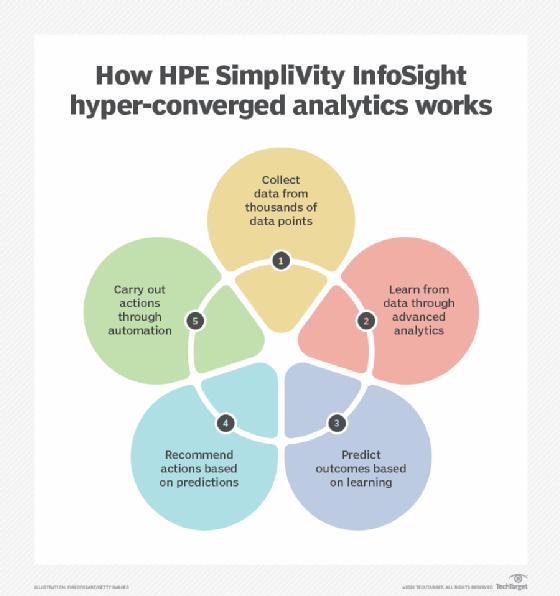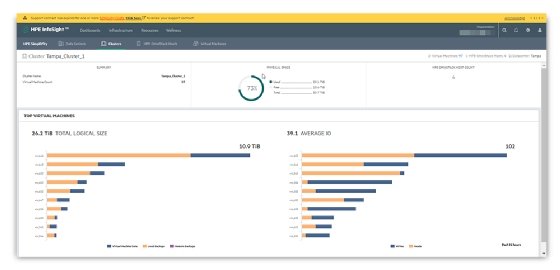How HPE SimpliVity InfoSight hyper-converged analytics works (original) (raw)
SimpliVity with InfoSight can predict and prevent hyper-convergence issues, take the guesswork out of capacity management, reduce support calls and lower operations expenses.
Hewlett Packard Enterprise recently added its SimpliVity hyper-converged infrastructure platform to the growing list of storage and server systems supported by HPE InfoSight predictive analytics. SimpliVity customers with active support contracts can now use InfoSight for free to access detailed metric data about hyper-converged clusters, nodes and virtual machines.
SimpliVity InfoSight provides granular insights into hyper-converged infrastructure environments to predict and preventing potential problems. This technology simplifies management, resolves issues quicker and reduces the number of support calls.
The InfoSight analytics platform
InfoSight is an artificial intelligence for IT operations (AIOps) platform that uses machine learning and predictive analytics to analyze system telemetry and address infrastructure issues with server, storage and virtualized resources. InfoSight collects telemetry data from HPE's global customer base to learn from those workloads and apply that knowledge to provide actionable management insights in customer data centers.
The InfoSight analytics process breaks down into five steps, as shown in the following figure. Although the steps imply a linear progression, the process is an ongoing data collection and learning effort, which improves predictions, recommendations and actions.

Now that InfoSight supports SimpliVity, the analytics process can incorporate data from across SimpliVity systems to provide extensive insights into hyper-converged resources. InfoSight takes the guesswork out of hyper-converged infrastructure management, particularly when it comes to VM administration. It can help improve performance, optimize resources and plan future capacity requirements, while reducing costs and freeing up IT resources for other projects.
Like most hyper-convergence platforms, HPE SimpliVity simplifies and streamlines system management through its software-defined architecture. InfoSight shifts the focus from software-defined management to an AIOps-based approach. This helps SimpliVity users better maintain resources, optimize performance and address potential issues.
Because InfoSight is software as a service, administrators do not need to install special software or manage local agents. However, they must register their SimpliVity systems with the InfoSight service. Once they do, InfoSight will start providing insights into their SimpliVity systems, which usually takes between 24 to 48 hours
What InfoSight brings to SimpliVity
InfoSight SimpliVity uses a dashboard that offers a unified view of the SimpliVity infrastructure. The dashboard provides system visibility at the data center, cluster, host and VM levels. Customers can quickly access performance and capacity metrics at any level and generate comprehensive reports about the health of their systems.
At the data center level, InfoSight offers a birds-eye view of each data center that contains registered systems to show the number of clusters, hosts and VMs, along with the amount of stored data, used physical space and capacity savings. In addition, InfoSight provides aggregated metrics across all data centers for a high-level perspective of an organization's operations.

The HPE InfoSight dashboard displays the VMs most likely to take up the most resources on a SimpliVity hyper-converged infrastructure cluster based on I/O and logical footprint.
InfoSight also offers extensive information about each cluster, with multiple views for gaining different insights into systems. For example, enterprises can see the list of clusters across all data centers. Each listing includes the cluster name, number of VMs, total data stored, compression ratio and deduplication ratio. Through other views, SimpliVity InfoSight users can access cluster information, such as storage efficiency or cluster and host capacity.
At the host level, organizations can dig into even more granular system information. For example, they can view the host's serial number, virtual controller and model name, as well as information about software versions and entitlement -- as it relates to a system's active support status. Users can also drill down into more specific details about the host, such as the SimpliVity model, hypervisor type, VM count or capacity savings.
In addition, InfoSight lets users monitor VM throughput, I/O and latency. The service also provides multiple views related to VM consumption. For example, enterprises can view details about top VM contributors, which includes information about the highest read/write I/O activity within a 24-hour period, or they can access information about the top VMs in a cluster to see the amount of physical space used, the total logical size or other details.
InfoSight offers more than just simple metrics about SimpliVity systems, however. The service uses predictive analytics to support resource planning, provide insights into historical capacity consumption and deliver proactive wellness alerts that notify SimpliVity users when they are about to run out of capacity or when an unexpected event is about to occur.
The InfoSight advantage
HPE SimpliVity customers with active support contracts have much to gain by giving InfoSight a try. The service is free and can provide deep insights into hyper-converged infrastructure systems across all their data centers.
However, to do its job, InfoSight must connect directly to the customer's SimpliVity systems to collect telemetry data, something that might not sit well in organizations with overriding concerns about security and privacy. On the other hand, those comfortable with InfoSight's data collection could realize many important benefits, with little effort on their part.
SimpliVity with HPE InfoSight enabled can predict and prevent hyper-converged infrastructure problems before they happen. It takes the guesswork out of capacity management, while reducing the number of support calls and lowering operational expenses. The free service is worth a try for all but the most security- and privacy-conscious organizations.
Next Steps
HPE SimpliVity gains cloud backup and Kubernetes CSI plug-in
HPE unveils Nimble dHCI, InfoSight on SimpliVity HCI
10 top hyper-converged infrastructure vendors and products
Hyper-converged data center vendors innovate, evolve products
A guide to hyper-converged data resiliency options and requirements
 Post-acquisition strategy and why storage mergers go bad
Post-acquisition strategy and why storage mergers go bad  By: Dave Raffo
By: Dave Raffo  hyper-converged storage
hyper-converged storage  By: Brien Posey
By: Brien Posey  By: Robert Sheldon
By: Robert Sheldon  Disaggregated hyper-converged infrastructure vs. traditional HCI
Disaggregated hyper-converged infrastructure vs. traditional HCI